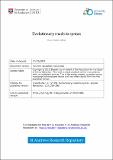Files in this item
Evolutionary roads to syntax
Item metadata
| dc.contributor.author | Zuberbuhler, Klaus | |
| dc.date.accessioned | 2020-04-09T23:32:25Z | |
| dc.date.available | 2020-04-09T23:32:25Z | |
| dc.date.issued | 2019-05 | |
| dc.identifier | 257793989 | |
| dc.identifier | b4a90fa2-4679-4817-9c78-bc8409051571 | |
| dc.identifier | 85063676464 | |
| dc.identifier | 000467013300026 | |
| dc.identifier.citation | Zuberbuhler , K 2019 , ' Evolutionary roads to syntax ' , Animal Behaviour , vol. 151 , pp. 259-265 . https://doi.org/10.1016/j.anbehav.2019.03.006 | en |
| dc.identifier.issn | 0003-3472 | |
| dc.identifier.other | ORCID: /0000-0001-8378-088X/work/64360724 | |
| dc.identifier.uri | https://hdl.handle.net/10023/19777 | |
| dc.description | The author is grateful to the Swiss National Science Foundation (Project 31003A_166458) for support. | en |
| dc.description.abstract | Syntax is habitually named as what sets human language apart from other communication systems, but how did it evolve? Comparative research on animal behaviour has contributed in important ways, with mainly three sets of data. First, animals have been subjected to artificial grammar tasks, based on the hypothesis that human syntax has evolved through advanced computational capacity. In these experiments humans generally outperform animals, but there are questions about validity, as experimental stimuli are (deliberately) kept devoid of semantic content. Second, animal communication has been compared in terms of the surface structures with the aim of developing a typology of animal syntax, based on the hypothesis that syntax is an evolutionary solution to the constraints of small signal repertoires. A wide range of combinatorial phenomena has been described, mainly in nonhuman primates, but there is little support for the hypothesis that syntax has emerged due to repertoire size constraints. A third way of studying the evolution of syntax is to compare how animals perceive and communicate about external events, the mental deep structure of syntax. Human syntax is closely aligned with how we perceive events in terms of agency, action and patience, each with subsidiary functions. The event perception hypothesis has been least explored in animals and requires a serious research programme. | |
| dc.format.extent | 884697 | |
| dc.language.iso | eng | |
| dc.relation.ispartof | Animal Behaviour | en |
| dc.subject | Argument structure | en |
| dc.subject | Combinatoriality | en |
| dc.subject | Communication | en |
| dc.subject | Compositionality | en |
| dc.subject | Computational capacity | en |
| dc.subject | Event perception | en |
| dc.subject | Grammar | en |
| dc.subject | Language | en |
| dc.subject | Meaning | en |
| dc.subject | Repertoire constraints | en |
| dc.subject | RC0321 Neuroscience. Biological psychiatry. Neuropsychiatry | en |
| dc.subject | QH301 Biology | en |
| dc.subject | T-NDAS | en |
| dc.subject.lcc | RC0321 | en |
| dc.subject.lcc | QH301 | en |
| dc.title | Evolutionary roads to syntax | en |
| dc.type | Journal article | en |
| dc.contributor.institution | University of St Andrews. Institute of Behavioural and Neural Sciences | en |
| dc.contributor.institution | University of St Andrews. Centre for Social Learning & Cognitive Evolution | en |
| dc.contributor.institution | University of St Andrews. School of Psychology and Neuroscience | en |
| dc.identifier.doi | 10.1016/j.anbehav.2019.03.006 | |
| dc.description.status | Peer reviewed | en |
| dc.date.embargoedUntil | 2020-04-10 |
This item appears in the following Collection(s)
Items in the St Andrews Research Repository are protected by copyright, with all rights reserved, unless otherwise indicated.

